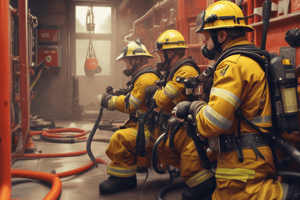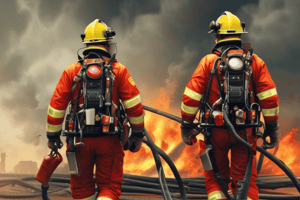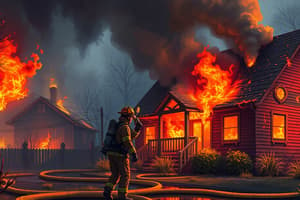Podcast
Questions and Answers
What is the primary action defined as moving a charged hose towards the seat of the fire?
What is the primary action defined as moving a charged hose towards the seat of the fire?
- Hit and Move
- Deployment
- Push
- Advance (correct)
Which term is used to refer to the command for hose loaders to advance the hose towards the next friction point?
Which term is used to refer to the command for hose loaders to advance the hose towards the next friction point?
- Hit and Move
- Advance
- Bump up (correct)
- Surplus
What does the term 'Friction Point' refer to in hose operations?
What does the term 'Friction Point' refer to in hose operations?
- An object causing resistance in hose advancement (correct)
- The speed of hose deployment
- The command given to the nozzle team
- The location where fire is being attacked
Which statement best describes the role of the 'Nozzle team'?
Which statement best describes the role of the 'Nozzle team'?
What does 'Hit and Move' involve in fire attack strategy?
What does 'Hit and Move' involve in fire attack strategy?
The term 'Surplus' in the context of firefighting means what?
The term 'Surplus' in the context of firefighting means what?
What is the purpose of the 'Leader Line' in firefighting?
What is the purpose of the 'Leader Line' in firefighting?
What does the action of 'Push' refer to during fire attack?
What does the action of 'Push' refer to during fire attack?
Which term refers to the personnel assisting with the hose advancement excluding the nozzle team?
Which term refers to the personnel assisting with the hose advancement excluding the nozzle team?
The term 'Bump up' is a command used for hose loaders to retreat from the nozzle to the previous friction point.
The term 'Bump up' is a command used for hose loaders to retreat from the nozzle to the previous friction point.
The action known as 'Hit and Move' involves cooling the fire before immediately retreating from the area.
The action known as 'Hit and Move' involves cooling the fire before immediately retreating from the area.
A 'Leader Line' refers to a supply line capable of supplying hoses of any size up to 4 inches.
A 'Leader Line' refers to a supply line capable of supplying hoses of any size up to 4 inches.
The 'Nozzle team' is exclusively composed of hose loaders.
The 'Nozzle team' is exclusively composed of hose loaders.
The action of 'Push' refers to the nozzle team moving backward while flowing water.
The action of 'Push' refers to the nozzle team moving backward while flowing water.
Surplus in firefighting refers to the process of adding more hose behind the nozzle team to facilitate advancement.
Surplus in firefighting refers to the process of adding more hose behind the nozzle team to facilitate advancement.
Friction points in hose operations are primarily located at the water source.
Friction points in hose operations are primarily located at the water source.
The act of Deployment in firefighting is synonymous with the term Stretch, referring to laying out hose from the apparatus.
The act of Deployment in firefighting is synonymous with the term Stretch, referring to laying out hose from the apparatus.
Personnel referred to as 'Loaders' are responsible for coordinating the push of the nozzle firefighter during the attack.
Personnel referred to as 'Loaders' are responsible for coordinating the push of the nozzle firefighter during the attack.
The term 'Advance' in firefighting indicates the action of moving a charged hose away from the fire.
The term 'Advance' in firefighting indicates the action of moving a charged hose away from the fire.
Flashcards are hidden until you start studying
Study Notes
Hose and Nozzles
- Hose management is crucial during fire operations, involving specific commands and techniques to ensure efficiency and safety.
- The nozzle team plays a vital role in deploying water effectively during a fire attack, with specific responsibilities assigned to each member.
Fire Attack
- The fire attack strategy includes advancing the hose line directly towards the seat of the fire while ensuring proper coordination among team members.
- "Hit and Move" technique involves cooling the fire or gases and then repositioning for a subsequent attack.
- Personnel designated as loaders assist with hose management but are not part of the nozzle team, which consists of the nozzle firefighter and a backup firefighter.
- Effective deployment of hose lines is essential for gaining quick access to the fire scene, employing a pre-stretch technique to manage the working line properly.
Glossary
- Advance: Moving a charged hose toward the fire source.
- Bump Up: Directing hose loaders to advance the hose at the next friction point.
- Deployment/Stretch: Laying out hose from the apparatus with adequate line for firefighting.
- Friction Point: Objects causing resistance during hose advancement.
- Hit and Move: Cooling targeted areas before relocating for further attack.
- Leader Line: A supply line that feeds smaller hose lines (2 ½ to 1 ¾ inches).
- Loaders: Firefighters assisting in hose advancement, excluding the nozzle team.
- Nozzle Team: Comprising nozzle firefighter and backup firefighter, focused on applying water.
- Push: Action of advancing while flowing water, with the backup firefighter assisting.
- Surplus: Pre-loaded hose behind the nozzle team to ease advancement without added resistance.
Hose and Nozzles
- Hose management is crucial during fire operations, involving specific commands and techniques to ensure efficiency and safety.
- The nozzle team plays a vital role in deploying water effectively during a fire attack, with specific responsibilities assigned to each member.
Fire Attack
- The fire attack strategy includes advancing the hose line directly towards the seat of the fire while ensuring proper coordination among team members.
- "Hit and Move" technique involves cooling the fire or gases and then repositioning for a subsequent attack.
- Personnel designated as loaders assist with hose management but are not part of the nozzle team, which consists of the nozzle firefighter and a backup firefighter.
- Effective deployment of hose lines is essential for gaining quick access to the fire scene, employing a pre-stretch technique to manage the working line properly.
Glossary
- Advance: Moving a charged hose toward the fire source.
- Bump Up: Directing hose loaders to advance the hose at the next friction point.
- Deployment/Stretch: Laying out hose from the apparatus with adequate line for firefighting.
- Friction Point: Objects causing resistance during hose advancement.
- Hit and Move: Cooling targeted areas before relocating for further attack.
- Leader Line: A supply line that feeds smaller hose lines (2 ½ to 1 ¾ inches).
- Loaders: Firefighters assisting in hose advancement, excluding the nozzle team.
- Nozzle Team: Comprising nozzle firefighter and backup firefighter, focused on applying water.
- Push: Action of advancing while flowing water, with the backup firefighter assisting.
- Surplus: Pre-loaded hose behind the nozzle team to ease advancement without added resistance.
Studying That Suits You
Use AI to generate personalized quizzes and flashcards to suit your learning preferences.




